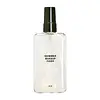What's inside
What's inside
 Key Ingredients
Key Ingredients

No key ingredients
 Benefits
Benefits

 Concerns
Concerns

 Ingredients Side-by-side
Ingredients Side-by-side

Water
Skin ConditioningVinyl Dimethicone/Methicone Silsesquioxane Crosspolymer
Rosa Damascena Flower Water
MaskingButylene Glycol
HumectantHyaluronic Acid
HumectantFerulic Acid
AntimicrobialSodium Hyaluronate
HumectantPanthenol
Skin ConditioningPhenoxyethanol
PreservativeEctoin
Skin ConditioningHydroxyacetophenone
AntioxidantPEG-11 Methyl Ether Dimethicone
EmulsifyingLactobacillus Ferment
Skin ConditioningLactobacillus/Ganoderma Lucidum Extract/Lentinus Edodes Extract Ferment Filtrate
Skin ConditioningSaccharomyces Ferment
Skin ConditioningDisodium EDTA
Hectorite
AbsorbentBis-Ethoxydiglycol Cyclohexane 1,4-Dicarboxylate
EmollientLinalool
PerfumingHexyl Cinnamal
PerfumingCitric Acid
BufferingMethyl Diisopropyl Propionamide
MaskingAroma
Caprylhydroxamic Acid
1,2-Hexanediol
Skin ConditioningWater, Vinyl Dimethicone/Methicone Silsesquioxane Crosspolymer, Rosa Damascena Flower Water, Butylene Glycol, Hyaluronic Acid, Ferulic Acid, Sodium Hyaluronate, Panthenol, Phenoxyethanol, Ectoin, Hydroxyacetophenone, PEG-11 Methyl Ether Dimethicone, Lactobacillus Ferment, Lactobacillus/Ganoderma Lucidum Extract/Lentinus Edodes Extract Ferment Filtrate, Saccharomyces Ferment, Disodium EDTA, Hectorite, Bis-Ethoxydiglycol Cyclohexane 1,4-Dicarboxylate, Linalool, Hexyl Cinnamal, Citric Acid, Methyl Diisopropyl Propionamide, Aroma, Caprylhydroxamic Acid, 1,2-Hexanediol
 Reviews
Reviews

Ingredients Explained
These ingredients are found in both products.
Ingredients higher up in an ingredient list are typically present in a larger amount.
Butylene Glycol (or BG) is used within cosmetic products for a few different reasons:
Overall, Butylene Glycol is a safe and well-rounded ingredient that works well with other ingredients.
Though this ingredient works well with most skin types, some people with sensitive skin may experience a reaction such as allergic rashes, closed comedones, or itchiness.
Learn more about Butylene GlycolCitric Acid is an alpha hydroxy acid (AHA) naturally found in citrus fruits like oranges, lemons, and limes.
Like other AHAs, citric acid can exfoliate skin by breaking down the bonds that hold dead skin cells together. This helps reveal smoother and brighter skin underneath.
However, this exfoliating effect only happens at high concentrations (20%) which can be hard to find in cosmetic products.
Due to this, citric acid is usually included in small amounts as a pH adjuster. This helps keep products slightly more acidic and compatible with skin's natural pH.
In skincare formulas, citric acid can:
While it can provide some skin benefits, research shows lactic acid and glycolic acid are generally more effective and less irritating exfoliants.
Most citric acid used in skincare today is made by fermenting sugars (usually from molasses). This synthetic version is identical to the natural citrus form but easier to stabilize and use in formulations.
Read more about some other popular AHA's here:
Learn more about Citric AcidPhenoxyethanol is a preservative that has germicide, antimicrobial, and aromatic properties. Studies show that phenoxyethanol can prevent microbial growth. By itself, it has a scent that is similar to that of a rose.
It's often used in formulations along with Caprylyl Glycol to preserve the shelf life of products.
Water. It's the most common cosmetic ingredient of all. You'll usually see it at the top of ingredient lists, meaning that it makes up the largest part of the product.
So why is it so popular? Water most often acts as a solvent - this means that it helps dissolve other ingredients into the formulation.
You'll also recognize water as that liquid we all need to stay alive. If you see this, drink a glass of water. Stay hydrated!
Learn more about Water